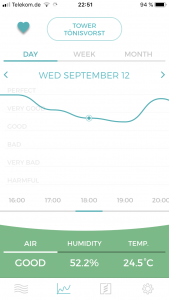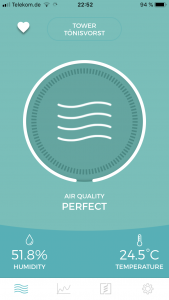November 28, 2018
Pilates and Plants! The Power of Air-Cleansing
by Reiner Grootenhuis
Does every Pilates studio need air-cleansing plants? The simple answer to this question is yes, a thousand times yes. Let me give you a bit of a background story.
I do not have a green thumb, even if some clients insist I that I do, and I never had a fondness for gardening or indoor plants. Until one day some big Swiss Balls arrived and were stored in the rather huge ladies changing room. Immediately, a very strong chemical scent started emanating from them, filling the entire room.
Since the day those balls arrived, my first task (and real morning challenge) was to open both big windows in that changing room for at least 10 minutes to clear the air. Otherwise, staying in the room for more than a minute was absolutely impossible. I also had to keep the window cracked open all day. But keeping the windows open like this in winter? No way. There had to be another solution, so I started learning about improving indoor air quality.
According to the US Environmental Protection Agency, indoor pollution can be up to five times higher than outdoor pollution. Our building materials, paints, adhesives, furniture, synthetic textiles, detergents, combustion, tobacco, electronics, human activities, deodorants, cosmetics and, amazingly enough, even our Pilates studio equipment are all filling the air with unhealthy volatile organic compounds (VOCs) that can include formaldehyde, xylene, benzene, ammonia, alcohols and acetone.

Although these VOCs are generally only found in low concentrations, they can still have a negative effect on our health since, when you combine home and office time, we spend almost 90% of our time indoors. Since the first energy crisis decades ago, homes have become more and more airtight and people are increasingly showing symptoms like allergies, asthma, eye & nose irritations, fatigue, etc. – often called “sick building syndrome.”
Breathing is a big part of what we do in Pilates, as documented in Return to Life:
To breathe correctly you must completely exhale and inhale, always trying very hard to “squeeze” every atom of impure air from your lungs in much the same manner that you would wring every drop of water from a wet cloth…. Admittedly, it is rather difficult to gain ideal physical fitness under the handicap of daily breathing the soot-saturated air of our crowded and noisy cities. On the other hand, we can more quickly realize this ambition if we are privileged to breathe the pure fresh air of the country and forests….
Replace yesterday’s “soot-saturated” cities with today’s “VOC-saturated” interior spaces – the challenge is the same – so let’s return to my Swiss Ball problem.
I read that the Snake Plant (Sansevieria trifasciata laurentii) had proven to be effective in air cleaning. So I bought two pots and put them in the ladies changing room. Within just a few days, the smell was dramatically reduced. Not gone but reduced. A promising start, but more research was necessary.
I found that NASA, confronted with the task of creating a life-support system for a planned moon base, did extensive studies on treating and recycling air and wastewater. They found that plants could be a cornerstone for sustainable air cleaning. After extensive scientific experimentation, they discovered that certain microorganisms living in the soil close to the plant roots turned out to be the key!
 To test their scientific results in the real world, NASA created a “Biohome”, a small tightly sealed structure built with maximum air and energy insulation using plastic and other synthetic materials. Everyone who spent time inside that structure experienced symptoms of sick building syndrome, such as burning eyes and breathing problems. However, when they introduced plants into the Biohome, they decreased the VOC levels substantially. They also experimented with a planter that added activated-carbon to the soil and a special fan that allowed more air to be transported through the root system.
To test their scientific results in the real world, NASA created a “Biohome”, a small tightly sealed structure built with maximum air and energy insulation using plastic and other synthetic materials. Everyone who spent time inside that structure experienced symptoms of sick building syndrome, such as burning eyes and breathing problems. However, when they introduced plants into the Biohome, they decreased the VOC levels substantially. They also experimented with a planter that added activated-carbon to the soil and a special fan that allowed more air to be transported through the root system.
So, my next step wasn’t a fan-based planter (even though they actually exist, and I now own two of them) but a planter that used a kind of passive root ventilation using the stack effect and an inside flowerpot with many, many slits. Also, I used a Mauna Loa variety of the Spathe Flower (Spathiphyllum wallisii) in addition to the Snake Plant.
To cut a long story short, the smell from the Swiss Balls was gone and didn’t come back! Ever since, our studio has started to become populated by other plants like Sword Fern, Spider Plant, Ivy, Golden Can Palm and many more. Customers often smirked about my newly developed plant enthusiasm in the beginning, but are now on board and even volunteer to water the plants when I am on vacation.
 As a further development, I bought plant pots which, besides a fan pulling the air through the root system, also include an air quality measurement system. Now I can see how during classes, and especially towards the end of the day, the air quality starts to go down and how quickly it comes back during the breaks.
As a further development, I bought plant pots which, besides a fan pulling the air through the root system, also include an air quality measurement system. Now I can see how during classes, and especially towards the end of the day, the air quality starts to go down and how quickly it comes back during the breaks.
Sometimes the effects are truly astonishing. I moved a bigger Spathe Flower out of our combined Tower & Mat room into another room for no particular reason but aesthetics. One of my senior clients has a high allergic sensitivity to house dust and reacts with sneezing if house dust is in the air. With three robot vacuum cleaners with HEPA filters cleaning the studio in the early morning hours, there is no dust visible. Nevertheless, with the movement of the Spathe Flower out of the room, he started sneezing again. I moved the flower back to the room – no more sneezing. Studies have shown that plants can lower dust levels in a room by twenty percent!
Fun fact: Research also shows that even photos of plants can have a soothing effect. So, in case you feel like an actual plant might be too much of a commitment, start with a picture instead.
What are your experiences with air-cleansing plants? Please feel free to contact me about it!
Reiner Grootenhuis
 Besides obtaining a diploma in psychology an MB and being sexier than a Greek God, Reiner Grootenhuis has studied the healing and martial arts of the Southern Shaolin Monastery Weng Chun. He completed the training as a Pilates instructor for Pilates mat and equipment at the Pilates educational academy BASI®. He is the founder and operator of the largest Pilates teacher community worldwide, the pilates-contrology-forum on Facebook, which includes over 8400 Pilates instructors. At the beginning of 2012, he opened the pilates-powers Studio inNorth-Rhine-Westphalia Germany. Since 2014, he has been offering his own Pilates education program which is certified by the German Pilates Association.
Besides obtaining a diploma in psychology an MB and being sexier than a Greek God, Reiner Grootenhuis has studied the healing and martial arts of the Southern Shaolin Monastery Weng Chun. He completed the training as a Pilates instructor for Pilates mat and equipment at the Pilates educational academy BASI®. He is the founder and operator of the largest Pilates teacher community worldwide, the pilates-contrology-forum on Facebook, which includes over 8400 Pilates instructors. At the beginning of 2012, he opened the pilates-powers Studio inNorth-Rhine-Westphalia Germany. Since 2014, he has been offering his own Pilates education program which is certified by the German Pilates Association.

